World champion Kevin Schwantz now owns the Heron Rizla Suzuki RG500 that he made his Grand Prix debut on back in 1986. He winds back the years to relive an amazing season
It’s not unusual for a motorcyclist to want to track down the first bike they ever owned. It’s not even unusual for a Grand Prix racer to be reunited with the motorcycle on which they won a world championship decades earlier. But it is very unusual for a world champion to track down and buy the exact racer on which they made their Grand Prix debut.
That’s what 1993 World 500cc Grand Prix champion Texan Kevin Schwantz has managed to achieve. His 1986 Heron Suzuki XR70RV is considered by many to be the ultimate development of the RG500. Pushing out 148hp and weighing just 115kg, Suzuki’s obsolete square-four, two-stroke engine had been given a new lease on life with a futuristic carbon-composite chassis. The project was conceived, built and developed by a team of enthusiasts, financed by UK’s Heron Suzuki. Many of them would go on to play major roles in GP racing in the 1990s and beyond.

Schwantz’s carbon-framed Heron Suzuki is a fascinating time warp of GP500 technology of the mid-1980s. This was a period when cigarette money was filtering across from F1 car racing to GP motorcycles, when importers like Heron Suzuki had enough clout through sales to acquire factory racing engines and employ technicians who were specialists in their chosen fields of race engineering. A time when both factory and privateer teams were pushing the envelope of technical development.
For Schwantz, it was a crazy adventure that followed the instincts of a brash, brave but also a supremely talented Grand Prix novice. His efforts, along with other team Heron riders of the era, helped Suzuki renew its interest in GP racing and return with an all-new V4 in 1987 after a three-year absence.
In 1993, Schwantz gave Suzuki its first 500cc championship since 1982. His journey to the top of his sport started on this privateer Heron Suzuki at the Dutch TT in Assen in late June 1986.
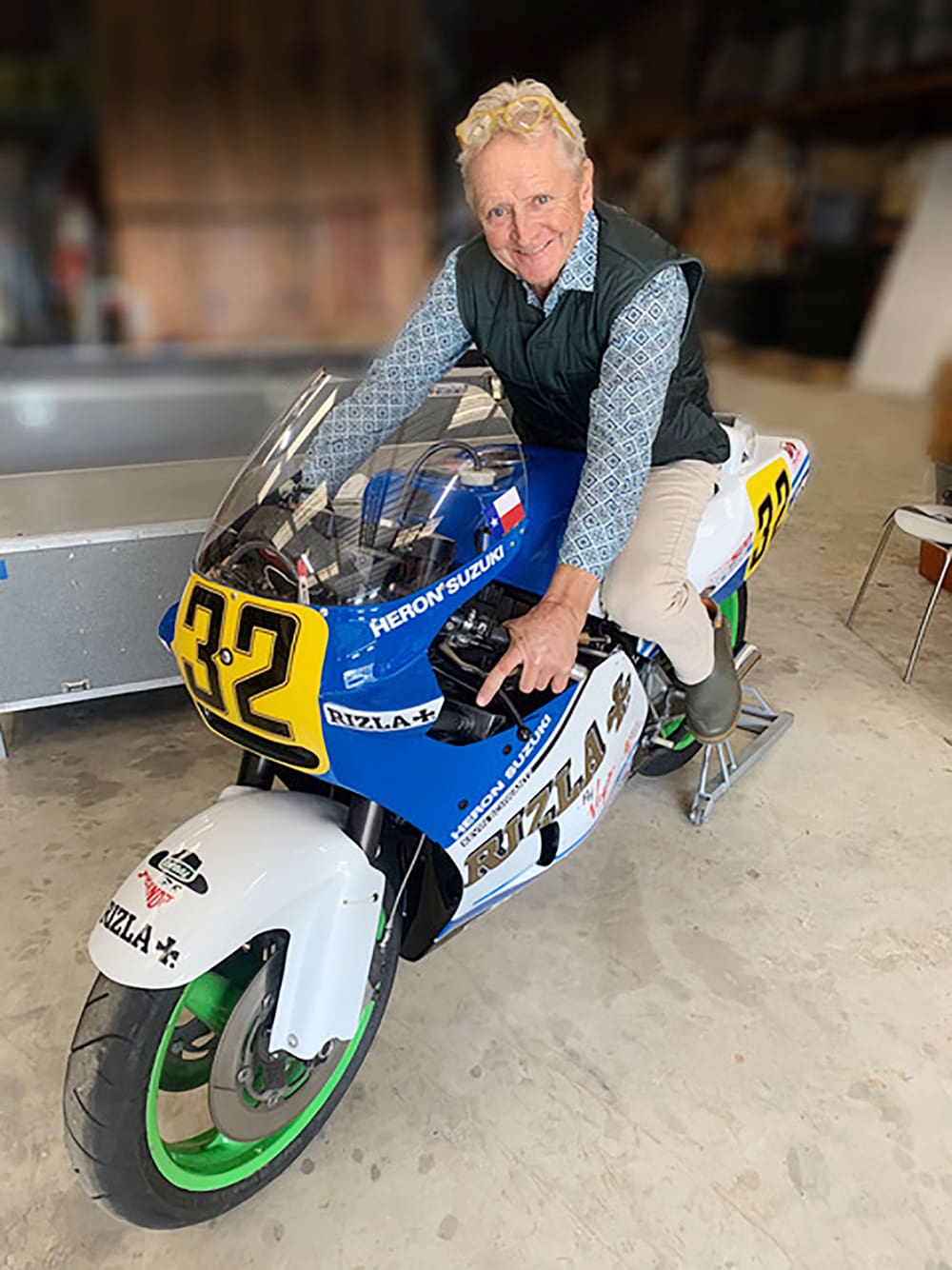
Leading into that year, Schwantz was already recognised in the US as a star of the future. By now a Yoshimura Suzuki rider, he had finished just 51 seconds behind Yamaha’s Eddie Lawson at the early March 1986 Daytona 200 on a much slower Suzuki GSX-R750. This result helped convince Kevin and his father, Jim, that they should try their luck in Europe.
It was a great time to be an American in GP500 racing. Lawson would win his second 500cc championship that year with Randy Mamola third and Mike Baldwin fourth. Getting selected as part of the 1986 Transatlantic Challenge series between the US and UK was Schwantz’s first taste of how different things were in Europe compared to the US. For a start, the UK was struggling out of a bleak winter while Kevin was fresh off the humid banks of Daytona’s speedbowl.
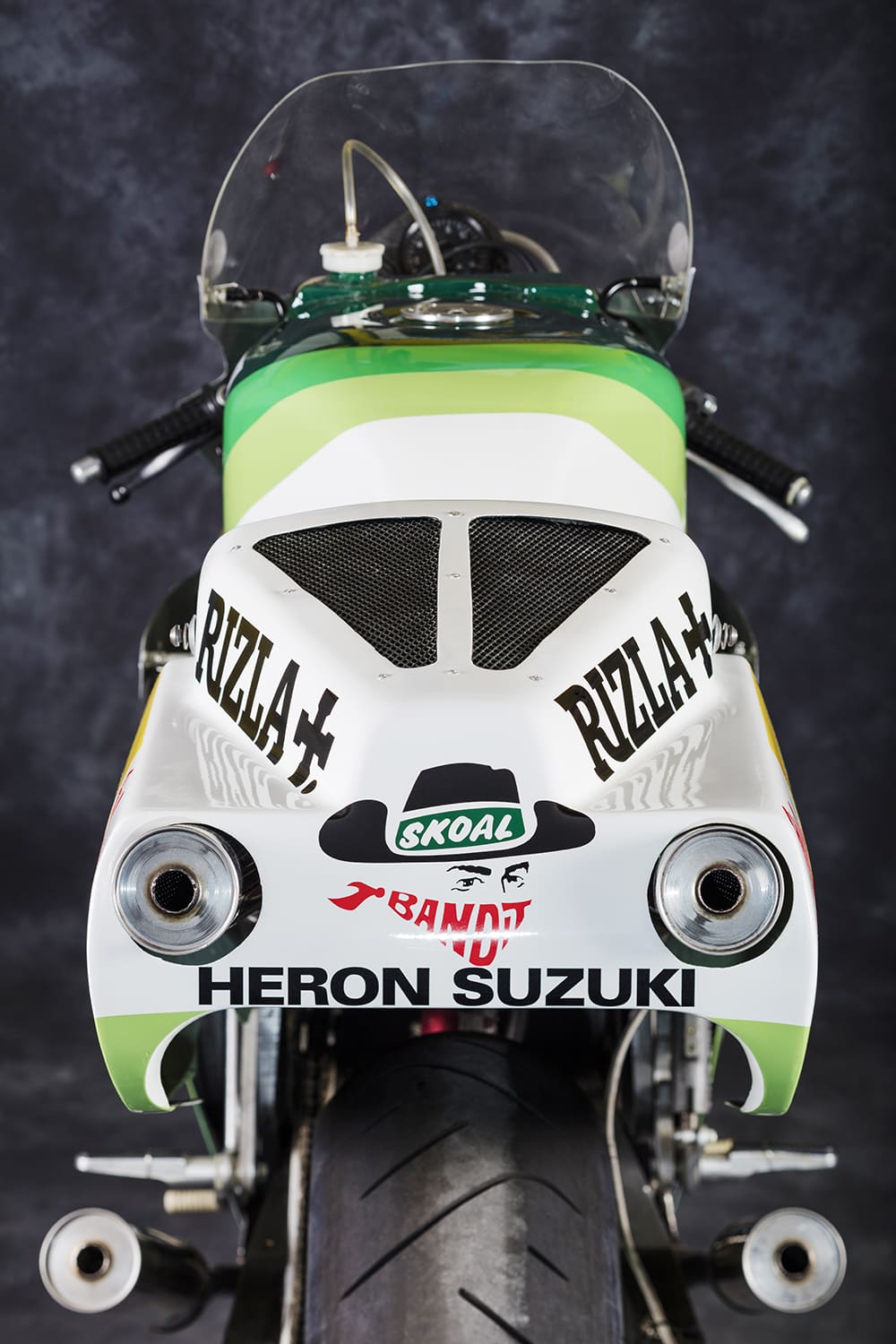
America had been slow to receive Suzuki’s all-new GSX-R750 and early development there revolved around ensuring reliability to such an extent that power was actually reduced. So when Schwantz was offered Tony Rutter’s proven 1985 TT-F1 racer he jumped at the opportunity to be on a competitive bike.
The reality was slightly different.
“It had seen a lot of action and was built to suit Tony, including having a righthand gear change,” Schwantz remembers. “I guess I could have embarrassed myself on it but all through my career it’s been ‘hell yeah, I’m going and taking every opportunity’.”
That attitude quickly became apparent in the eight races run over the freezing-cold Easter weekend in just a few weeks after sunny Daytona. Team USA lost to the Brits, but Schwantz was top points scorer and also took four race wins on circuits he’d never seen before. His raw ability and natural showmanship won over a huge crowd of UK fans, including the recently-retired racer-turned TV race commentator Barry Sheene.
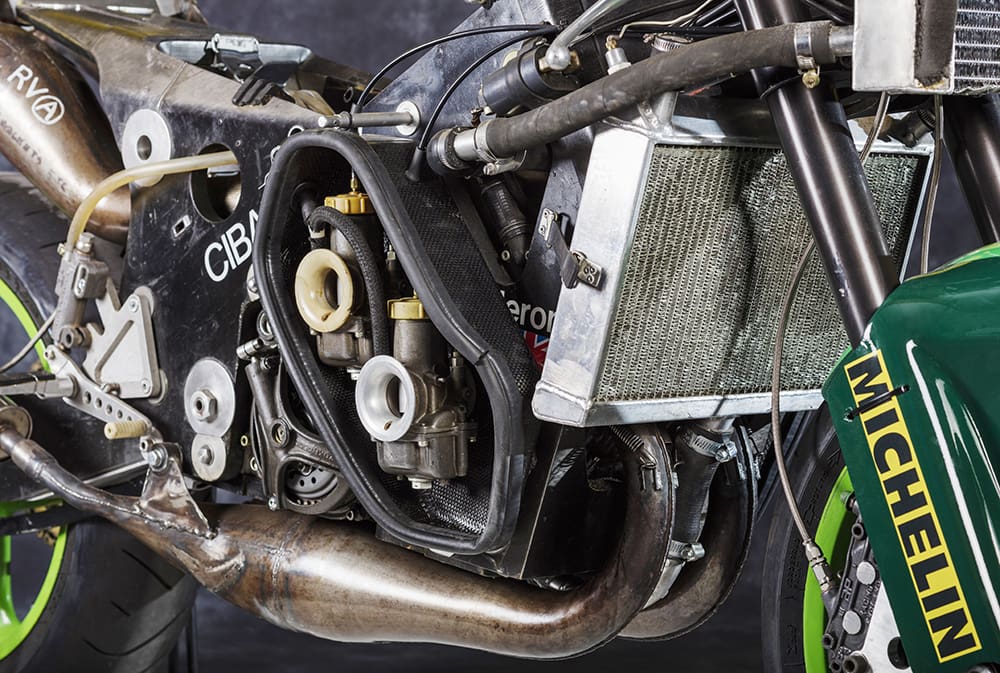
Sheene had won two 500cc world titles for Suzuki (1976 and 1977), and would now play a key role in Schwantz’s immediate future.
The first stage of Sheene’s involvement was explained to the TV audience at the start of the UK Spring Cup Invitational Race at Mallory Park soon after Easter.
This race was open to two-strokes and four-strokes and as Barry Sheene had little regard for four-strokes, once telling this author “why you would have all that rubbish sitting on top of a piston is beyond me,” his choice of motorcycle was obvious.
So Schwantz got his first taste of what a two-stroke GP500 would be like to race. While it wasn’t on the main stage of a world championship, it would be in front of an enthusiastic UK crowd all wrapped up in their winter woollies and hoping a few more hours of sunshine and bearable temperatures were just a few weeks away.
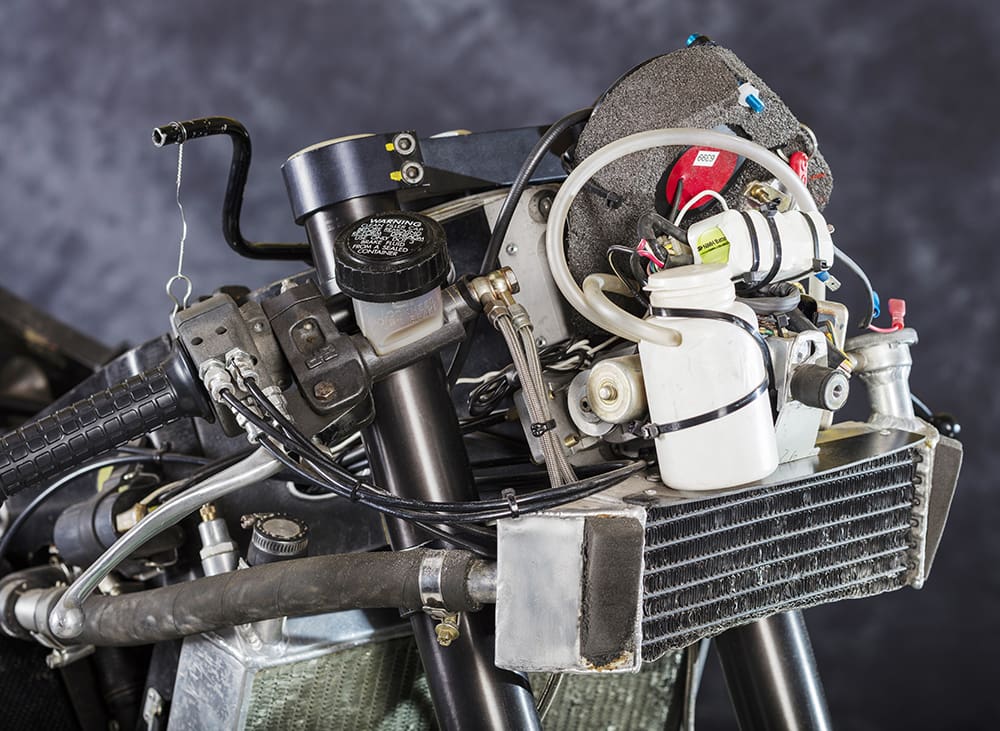
“I thought it would be a good thing to do something for him so I got on to Suzuki and asked if they’d loan him a bike and they said yes, he can have my old bike,” Sheene said.
One of Sheene’s old RG500s was pulled out of a museum and, as Barry explained in his distinctive Cockney accent, “they threw a new engine in it and got some good tyres and that. It’s a one-off deal to try and help motorcycle racing because it did a lot for me and I just thought it was a chance to do something for Kevin.”
When asked if he saw “a little of Kevin in himself” Sheene replied: “Yes, I do. He does tend to enjoy life a lot and he won’t do the sport any harm at all.”
But Schwantz could have done himself a lot of harm. Consider this: he was riding an obsolete but GP-spec 500cc two-stroke for the first time on a uniquely UK circuit that was undulating with high speed dips followed by tight corners involving a chicane called the Bus Stop and a curve called Devil’s Elbow. But Schwantz didn’t disappoint Sheene in front of an enthusiastic crowd and competing with some top international riders. He qualified fourth.
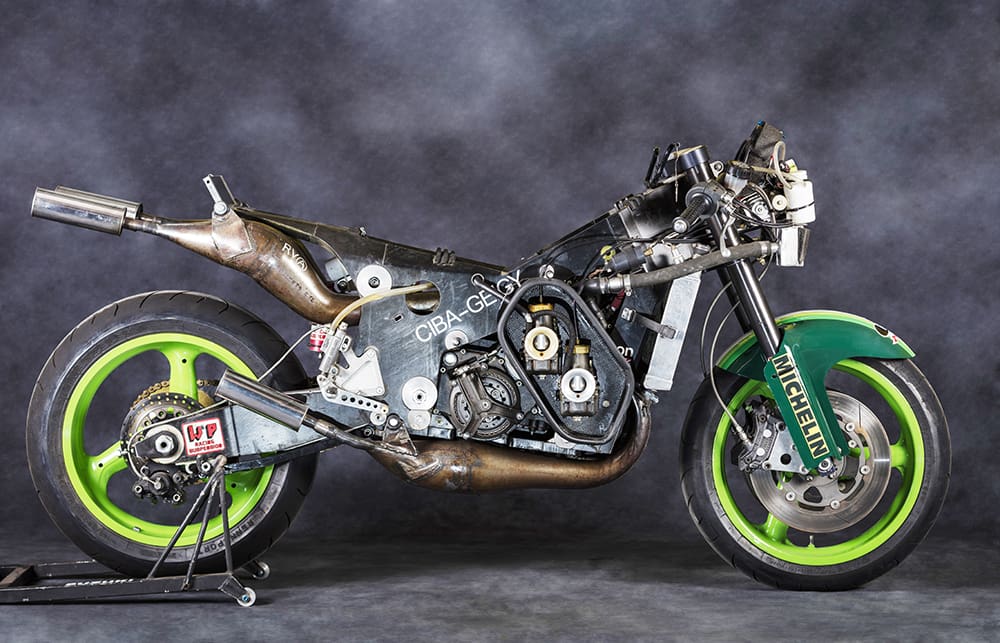
“Looking back on this I have to say that Barry Sheene really made it happen for me,” Schwantz remembers nowadays.
Australian Paul Lewis qualified on pole riding a carbon-framed Heron Suzuki ahead of the pride of Honda Britain’s official team, Roger Marshall and Roger Burnett. Despite a slow start Schwantz was soon up to third and closing quickly to early leader Lewis, a seven-time Australian champion, now overtaken by Marshall, a four-time UK champion.
As the race wore on, just 0.75sec separated first from third. Then Schwantz took the lead under brakes but faded slightly towards the end. Burnett used all his international race experience to snatch the win from Schwantz, with Marshall third and Lewis fourth.
Schwantz’s problem wasn’t a lack of race pace but rather a pin holding all four throttle cables together in the twistgrip had vibrated out, with obvious consequences.
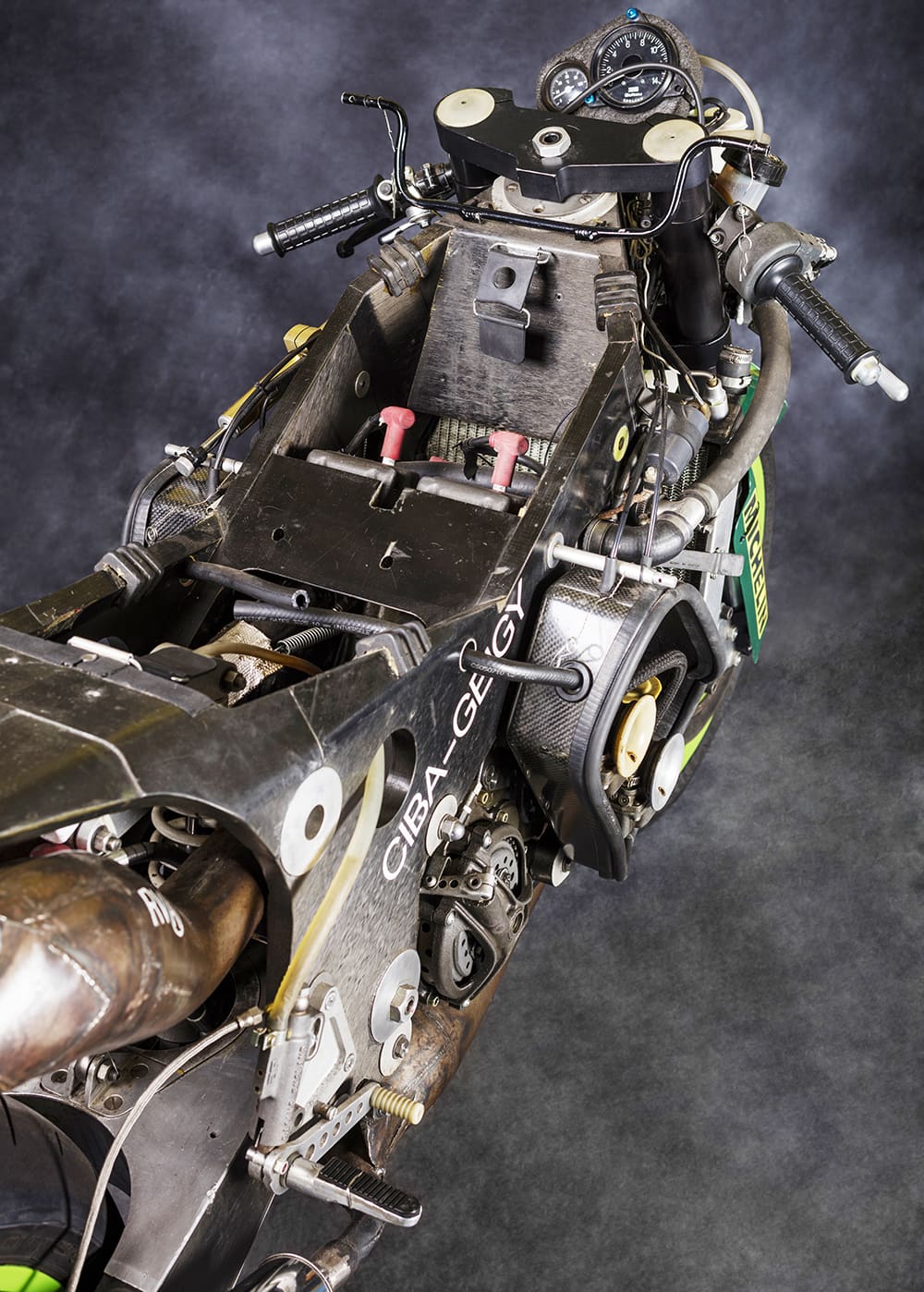
Heron Suzuki was mightily impressed and put a budget together to offer Schwantz the chance to make his GP500 debut at the Dutch TT at Assen on 28 June and then follow up at the Belgium GP at Spa-Francorchamps a week later. What could possibly go wrong?
Schwantz was balancing a season in AMA with the future prospect of his and father Jim’s efforts to get him into GP racing. So he was back in the US when the offer came up. And although Schwantz admits he “thought nothing of it”, in making a snap decision to race on two of the fastest and most demanding GP circuits, he was shocked by the Assen layout.
“It was barely wider than the average sidewalk and there was no edge between the circuit and the grass,” he remembers. “If you got the bike off line and into the grass you were an instant passenger!” Three-times world 500c champion, now team owner Kenny Roberts was also shocked when he saw Schwantz and his father at Assen.
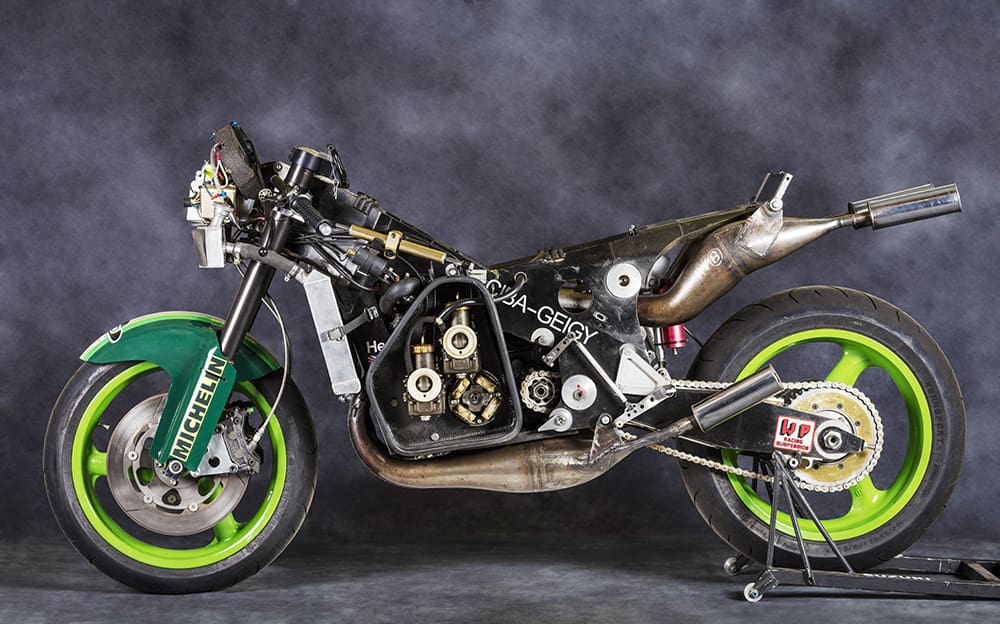
“He said: ‘I’m glad you’ve got to race in a GP – but why the hell here?’,” remembers Schwantz.
Heron Suzuki were well aware of the difficulties Schwantz faced and had pulled a trump card out of their sleeve. They had secured a brand-new road-going RG500 Gamma and quickly converted it to TT-F1 spec so that Kevin could get valuable track time in a support race on the Thursday.
That race was a round of the world TT-F1 championship and what happened next was totally unexpected. Instead of making up the numbers, and although severely down on power, Schwantz actually led the race for a while. He finished second to Joey Dunlop, who was on his way to a fifth consecutive world title on his factory Honda RVF750.
Now came time to qualify for the 500cc race.
“I must have been out on the grass at least six times,” says Schwantz. “You know, I don’t remember anything much about what changes we made to the bike.”
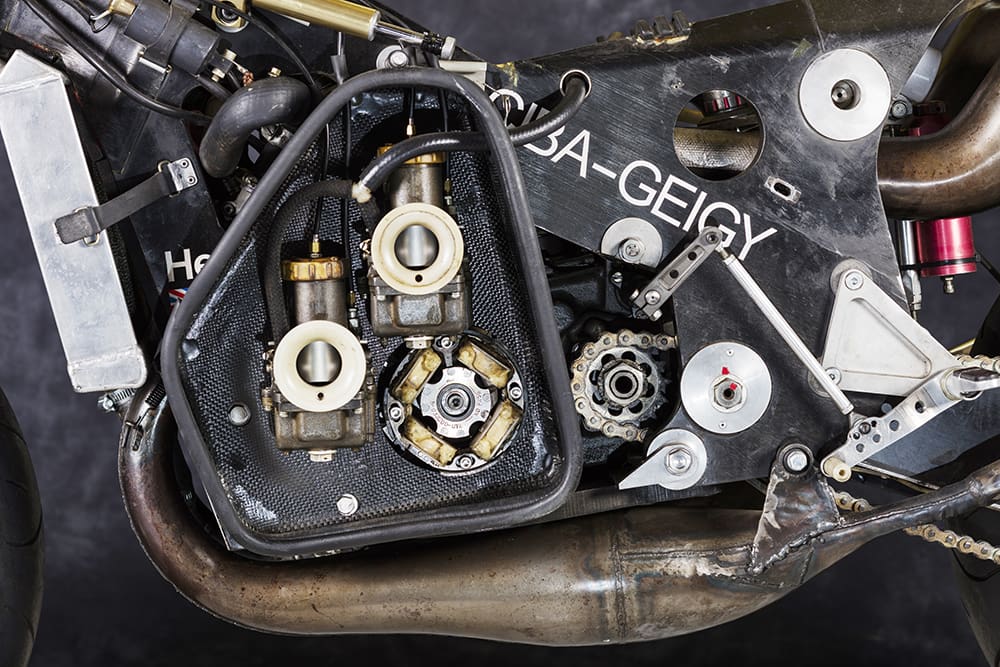
Schwantz’s focus was on learning the circuit and getting his head around such a narrow two-stroke powerband.
“You’d better be changing up when the revs hit 12,000rpm,” he remembers.
The photo of him in the race shows the raw power of the Suzuki while the skid marks on the Yoshimura leathers show evidence of previous crashes. The featherlight Heron Suzuki XR70RV was running at peak performance, the result of two seasons of development. Suzuki had retired from the 500cc GP class at the end of 1983 but continued to support Heron Suzuki and Italy’s Team Gallina with engines and chassis.
A search to keep the square-four, disc-valve engine competitive against Honda’s three-cylinder and Yamaha’s V4 led Heron Suzuki down the path of chassis development. In 1984, UK firm Armstrong had produced the first GP racer that used a carbon-fibre frame. Powered by a 250cc Rotax tandem twin engine, the chassis technology followed a growing trend in Formula 1.
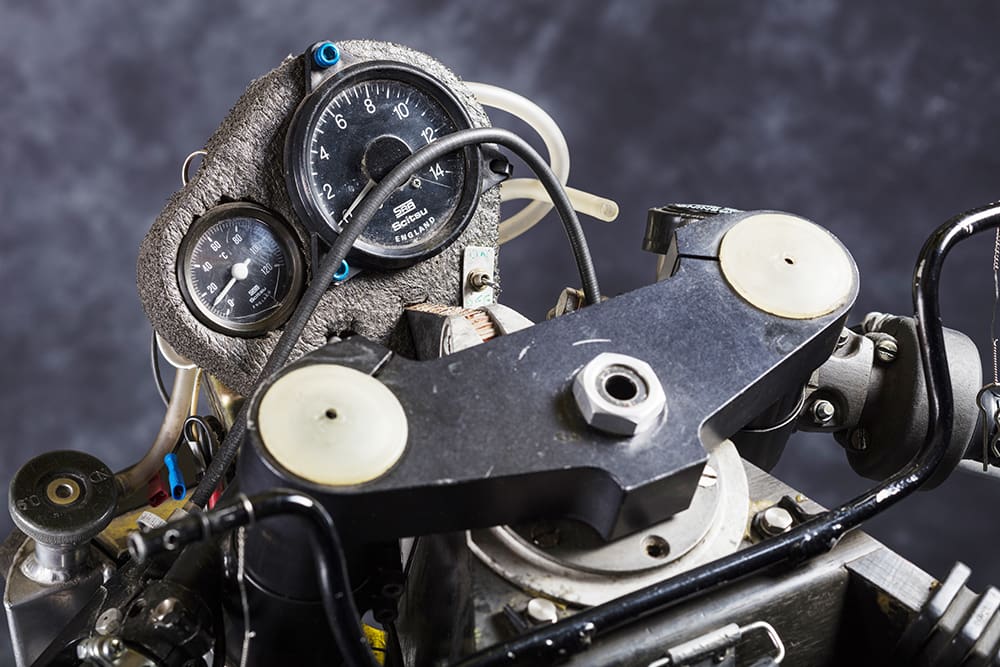
Now Heron Suzuki’s Nigel Leaper worked with UK aviation composite specialist firm Ciba-Geigy to build their version. The honeycomb composite chassis was compact, very rigid and ultra light. Initial testing by New Zealand racer Stu Avant showed potential and Rob McElnea raced it in several GPs and other international races in 1984.
Seven more were built, with variations to the honeycomb internals to refine the design. As well, there were experiments with carbon swingarms, upside-down White Power front forks, even carbon brake discs.
A range of engines, from a factory 1982 XR40 to a 1983 XR45-70 and eventually an XR70RV (with reed valves instead of disc valves) was developed in-house by Heron to produce more power using its own designs of exhausts, cylinder heads and intake air boxes.
The XR70RV Schwantz raced was the last version Heron built. Schwantz raced it in white-and-blue Rizla colours, while Niall Mackenzie raced it in the more common green-and-white Skoal Bandit colours. Paul Lewis also rode the number eight chassis but more often raced on chassis numbers five and six.

With no telemetry, the Heron team relied on the stopwatch and physical observation of Schwantz’s progress around the track to work out where his strengths and weaknesses lay. According to a mechanic’s log at Assen, minor changes were made to gearing, then suspension settings when Schwantz decked the fairing, while sticking throttles were fixed to prevent the bike “running on” in corners.
Qualifying in 12th was a great result but now came another great unknown: the push start. Schwantz had only ever raced using clutch starts and 1986 was to be the last year of push starts in GP racing.
“I can barely walk and chew bubble gum at the same time, so it absolutely sucked,” he said. “Those three-cylinder Hondas, you’d just look at them and they’d start, but I was the last or next to last away from the grid.”
With more than 20 riders firing up behind him, the risk of being hit and run over was very high.
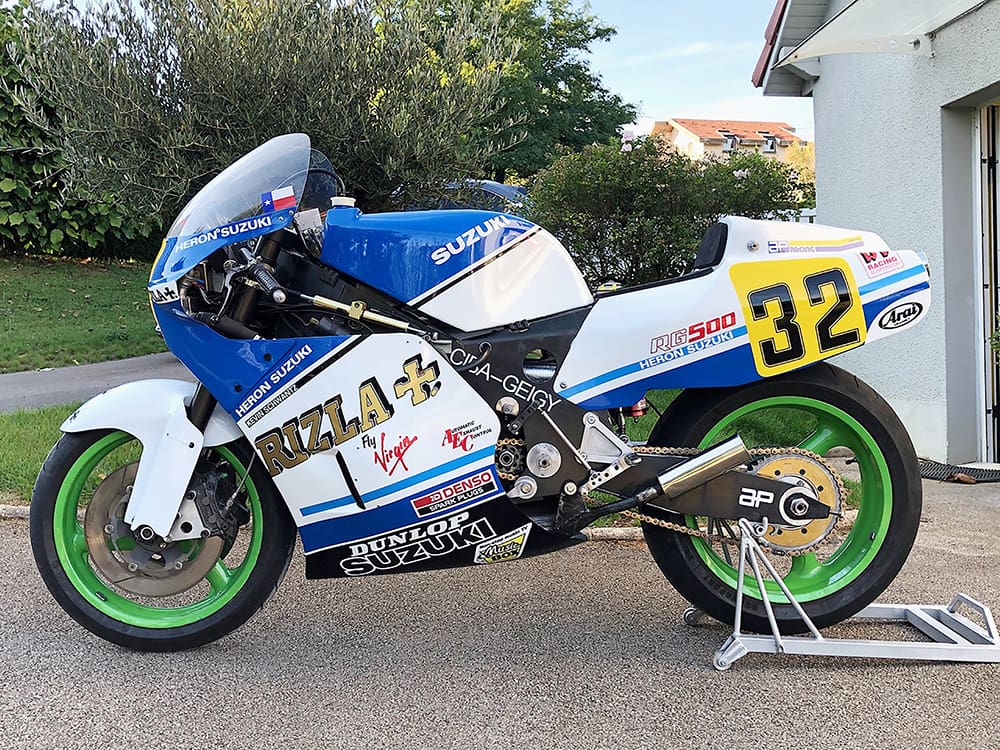
“I hadn’t planned on having to work my way back through the field,” Schwantz says.
“I got back into the top 10 but ran off the circuit, dragging dirt into the engine and eventually it seized.”
The next week at Spa, a crash on the warm-up lap found Heron technician Paul Boulton, who was supposed to be working for Paul Lewis, patch together Schwantz’s bike on the start line. After getting swamped again in the push start, Schwantz battled back to finish 10th and score his first championship point. He had climbed the first rung of a long ladder to GP success.
Balancing AMA and international racing, he didn’t start his full-time GP 500 career until 1988. His time at the top included 25 victories over 105 GPs, with 29 pole positions, 26 fastest laps, 51 podiums and, of course, that 1993 world title.

Meanwhile the carbon Heron Suzuki project faded, with the version Kevin raced eventually being bought by influential French collector and GP enthusiast Bernard Girardot-Miglierina in 2007. Bernard is a founding member and president of France’s world famous Amicale Spirit of Speed organisation.
He bought the bike in the corporate Skoal Bandit colours that Mackenzie had last raced it. That was how it was photographed by Phil Aynsley in 2016. But during his ownership Bernard had become intrigued by a fairing that had come with all the parts acquired with the bike. It bore the faint markings of a number 32, the number Schwantz used at Assen in 1986. He was able to confirm Kevin Schwantz’s link to it through the Heron team’s original race records.
This is because, unlike full factory racers, which get destroyed or broken down after a season of racing, with their development records kept secret, Heron Suzuki sold its surviving motorcycles as a complete package.
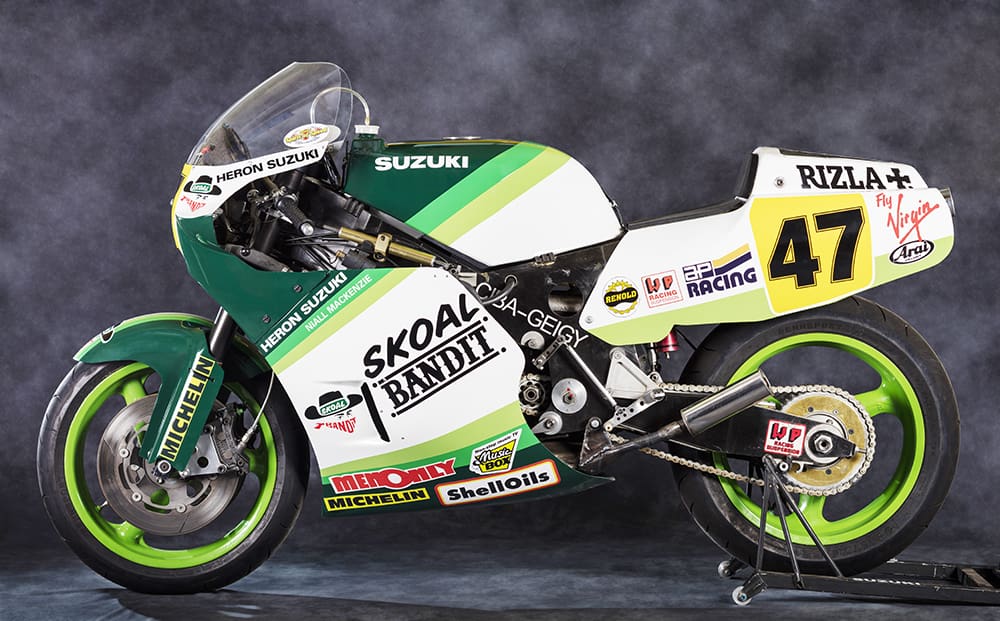
After discussions with some original Heron employees, Bernard realised this was a significant motorcycle for two reasons. Chassis number eight had been the motorcycle that Schwantz scored his first world championship point on. Niall Mackenzie also raced it during the season when Schwantz was back in the US. He finished the 1986 season on it in style, by qualifying on the front row at Misano and finishing eighth in the race.
Schwantz was also in the race on a different version of the bike. Although lapped, he finished 10th out of 24 finishers and gained another GP championship point.
In 2011, Bernard commissioned a full chassis-up restoration that included Paul Boulton’s expertise and memories of 1986. It was finished in Skoal Bandit livery, and that was how Mackenzie then demonstrated it at the UK’s Goodwood Festival of Speed. Interestingly, Mackenzie was the tester and racer for Armstrong’s carbon-framed 250/350cc racebikes back in 1984.
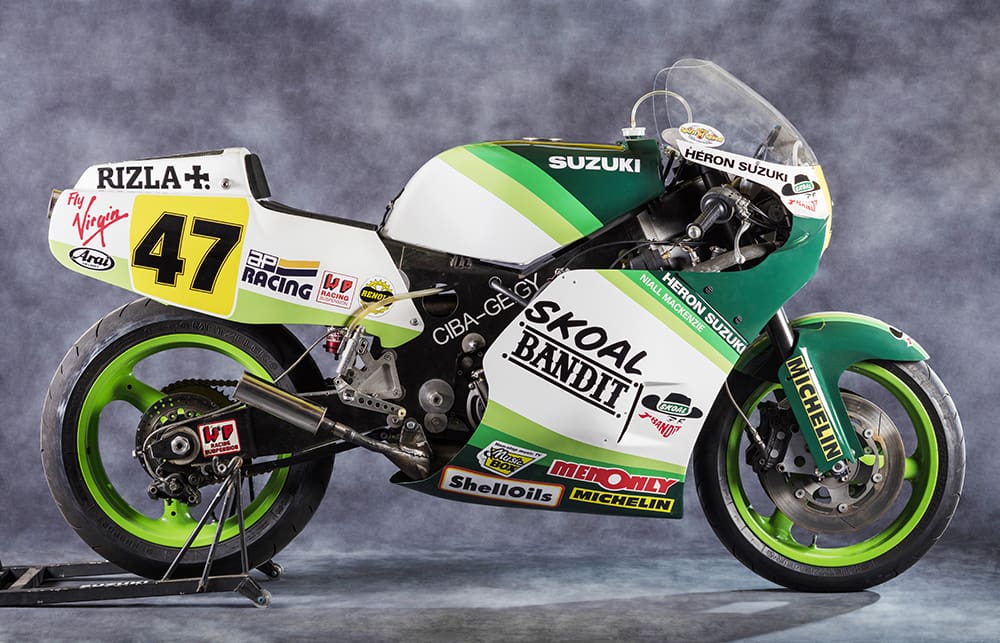
Bernard recently sold it to Schwantz in race-ready condition after replacing the panels with the Rizla livery, correct right down to the Lone Star flag Kevin and his dad Jim put on it in 1986. However, Kevin has no plans to ride it in anger in public.
“If you get two bikes together, chances are it will turn into a race,” he says. “So I might just rent a track and ride it around alone.”
Imagine the scene: the rasp of an RG500 at full howl, a flash of blue-and-white as the GP racer sweeps through a corner, a lone wolf on the prowl in the Lone Star state.
World champ Kevin Schwantz back in the zone on the very same racer that kick-started his GP career. Awesome.
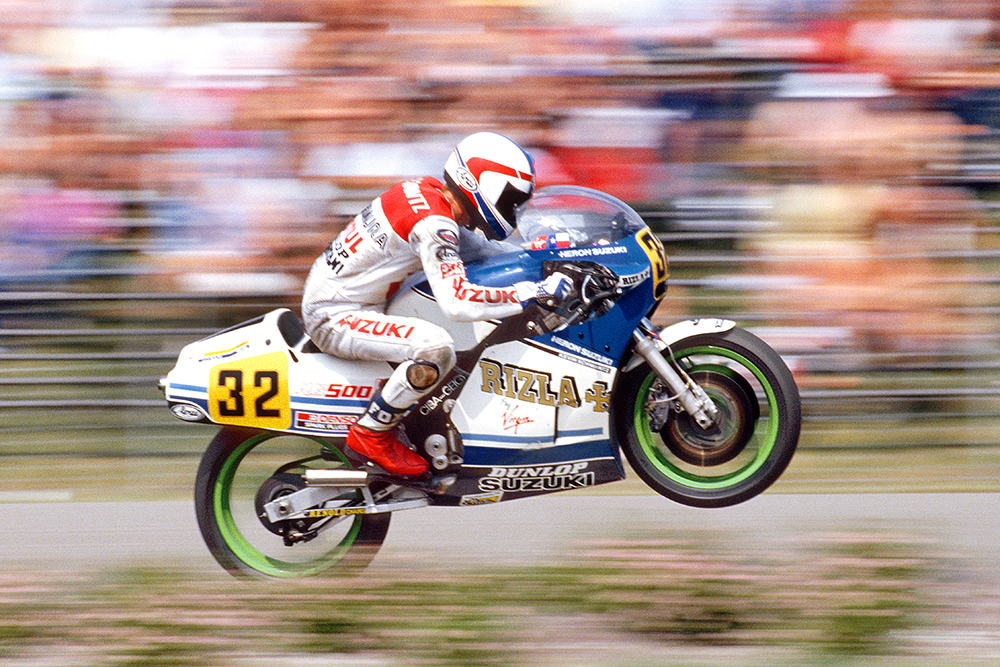
Kevin Schwantz, Suzuki 500, GP Assen 1986
Words Hamish Cooper Photography Phil Aynsley & Manfred Mothes